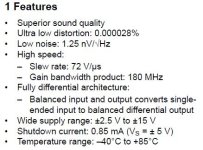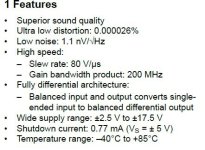The fully-differential OPA1637 (and it's predecessor OPA1632) have an enable (shutdown) pin.
I have an app where I would like to use that pin for a mute function.
Does anyone know if there is an output transient when switching from enabled to disabled or vice versa?
Jan
I have an app where I would like to use that pin for a mute function.
Does anyone know if there is an output transient when switching from enabled to disabled or vice versa?
Jan
There is according to figures 6-37 and 6-38 of the datasheet. I guess there will also be common-mode transients, and that signal will leak through the feedback components when the OPA1637 is off.
I missed those Marcel, I did look for them but didn't see them ...
In the mean time I rigged up a test on the OPA637 eval module I found back in my 'stuff' box...
There seems to be a transient when coming out of disable, and the disable doesn't fully suppress the signal (probably still leaks through the input/feedback resistors).
So it doesn't really look useful as a mute function.
Jan
In the mean time I rigged up a test on the OPA637 eval module I found back in my 'stuff' box...
There seems to be a transient when coming out of disable, and the disable doesn't fully suppress the signal (probably still leaks through the input/feedback resistors).
So it doesn't really look useful as a mute function.
Jan
Attachments
The successor of OPA1632 is OPA1633. OPA1637 has lower specs.The fully-differential OPA1637 (and it's predecessor OPA1632)
OPA1632 and OPA1633 have enable pins. The datasheet states this:
When disabled, the output stage is not in a high-impedance state.
OPA1637 has power down pin. According to datasheet:
In the power-down state, the amplifier outputs are in a high-impedance state
When disabled, the output stage is not in a high-impedance state.
OPA1637 has power down pin. According to datasheet:
In the power-down state, the amplifier outputs are in a high-impedance state
In differential applications at least I've found that series resistors and jfets across the output does a good job of muting in 1632. (The idea is not original.)

There are other jfets with lower RDS which might work better than the ones I used (which I could get at the time) J112? IIRC
There are other jfets with lower RDS which might work better than the ones I used (which I could get at the time) J112? IIRC
Last edited:
As you can see in the pics I posted, the 1637 when shutting down doesn't mute the signal.
It can't because there's a connection from input to output through the feedback network.
@bohrok2610 - I wasn't aware of the 1633, I will check it out!
Edit: the OPA1633 seems to be unavailable at the usual suspects ...
Jan
It can't because there's a connection from input to output through the feedback network.
@bohrok2610 - I wasn't aware of the 1633, I will check it out!
Edit: the OPA1633 seems to be unavailable at the usual suspects ...
Jan
Last edited:
The OPA1633 is a great chip but is unobtainium, even at TI ...The successor of OPA1632 is OPA1633. OPA1637 has lower specs.
Jan
Yes, I know. Would like to try it instead of OPA1632. It is a new chip so mass production may take some time.
H'm... neither good nor bad then? Innocuous as a connecting line between circuit elements in a simulator?I
Okay... is the OPA1632 much lesser than the OPA1633? In what way is the OPA1633 great? From a technical perspective?
Okay... is the OPA1632 much lesser than the OPA1633? In what way is the OPA1633 great? From a technical perspective?
Last edited:
You wonder why they would bother to create a new device...maybe just increased the operating currents of the input pair a bit? Or perhaps the fakes (the OPA1632 from China) are in such mass abundance they can't sell the originals?
Last edited:
According to the data sheet it's a power down pin and not a mute pin. So I would expect the purpose to be power savings rather than muting.There seems to be a transient when coming out of disable, and the disable doesn't fully suppress the signal (probably still leaks through the input/feedback resistors).
So it doesn't really look useful as a mute function.
Tom
- Home
- Design & Build
- Parts
- OPA1637 enable/disable transients

